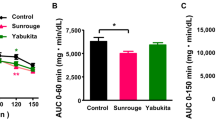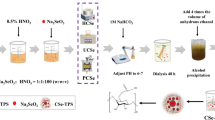Abstract
Various functional components in tea have been well developed, but less research has been explored on glycoproteins in tea. In this paper, three types of glycoprotein fractions, namely tea selenium-binding glycoprotein1–1 (TSBGP1–1), TSBGP2–1, and TSBGP3–1, respectively, were extracted and purified from selenium-enriched coarse green tea. Chemical analysis revealed that three fractions were glycoproteins, but their selenium content, molecular weight, and monosaccharide composition were significantly different. Fourier transforms infrared (FT-IR) analysis indicated that three fractions contained characteristic absorption peaks of glycoproteins but differed in secondary structural composition. Thermogravimetric (TG) analysis showed that the thermal stability of the three fractions was dramatically distinct. The in vitro hypoglycemic activity showed that TSBGPs significantly activated the insulin receptor substrate 2 (IRS2)/protein kinase B (Akt) pathway in LO2 cells, then enhanced glucose metabolism and inhibited gluconeogenesis, and finally ameliorated insulin resistance (IR) and glucose metabolism disorders. Furthermore, Pearson correlation analysis reveals that the hypoglycemic activity was significantly correlated with Se, protein, monosaccharide composition (especially glucose), molecular weight, and secondary structure. Our results show that Se-enriched tea glycoprotein is a desirable candidate for developing anti-diabetic food, and TSBGP-2 and TSBGP-3 had a better regulation effect. Our results can provide a research reference for the extraction, physicochemical property, and function of selenium-enriched plant glycoproteins.



Similar content being viewed by others
Data Availability
Not applicable.
References
Huo XZ, Wang X, Yang R et al (2020) Studies on the effect of a fupenzi glycoprotein on the fibrillation of bovine serum albumin and its antioxidant activity. Spectrochim Acta A Mol Biomol Spectrosc 237:118387
Yuan HL, Liu XL, Dai QC et al (2015) Exogenous natural glycoprotein multiple mechanisms of anti-tumor activity. Asian Pac J Cancer Prev 16:1331–1336
Rafiquzzaman SM, Kim EY, Kim YR et al (2013) Antioxidant activity of glycoprotein purified from Undaria pinnatifida measured by an in vitro digestion model. Int J Biol Macromol 62:265–272
Moura L, da Silva Costa HP, da Silva Neto JX et al (2020) Orally hypoglycemic activity of an insulin mimetic glycoprotein isolated from Cnidoscolus quercifolius pohl. (euphorbiaceae) seeds, cq-imp. Int J Biol Macromol 159:886–895
Chen H, Zhang M, Xie B (2005) Components and antioxidant activity of polysaccharide conjugate from green tea. Food Chem 90:17–21
Xu A, Lai W, Chen P et al (2021) A comprehensive review on polysaccharide conjugates derived from tea leaves: composition, structure, function and application. Trends Food Sci Technol 114:83–99
Zhu J, Wu M, Zhou H et al (2021) Liubao brick tea activates the pi3k-akt signaling pathway to lower blood glucose, metabolic disorders and insulin resistance via altering the intestinal flora. Food Res Int 148:110594
Rayman MP (2020) Selenium intake, status, and health: a complex relationship. Hormones (Athens) 19:9–14
Cheng L, Wang Y, He X et al (2018) Preparation, structural characterization and bioactivities of Se-containing polysaccharide: a review. Int J Biol Macromol 120:82–92
Fang C, Chen G, Kan J (2020) Comparison on characterization and biological activities of Mentha aplocalyx polysaccharides at different solvent extractions. Int J Biol Macromol 154:916–928
Zhu J, Du M, Wu M et al (2020) Preparation, physicochemical characterization and identification of two novel mixed ace-inhibiting peptides from two distinct tea alkali-soluble protein. Eur Food Res Technol 246:1483–1494
Nie S, Xie M, Wang Y (2005) Preparation of tea glycoprotein and its application as a calibration standard for the quantification and molecular weight determination of tea glycoprotein in different tea samples by high-performance gel-permeation chromatography. Anal Bioanal Chem 383:680–686
Wang Y, Yu L, Zhang J et al (2010) Study on the purification and characterization of a polysaccharide conjugate from tea flowers. Int J Biol Macromol 47:266–270
Li Z, Nie K, Wang Z et al (2016) Quantitative structure activity relationship models for the antioxidant activity of polysaccharides. PLoS One 11:0163536
Li X, Wang L (2016) Effect of extraction method on structure and antioxidant activity of Hohenbuehelia serotina polysaccharides. Int J Biol Macromol 83:270–276
Sun Y, Hou S, Song S et al (2018) Impact of acidic, water and alkaline extraction on structural features, antioxidant activities of Laminaria japonica polysaccharides. Int J Biol Macromol 112:985–995
Wang X, Wilson L, Cosgrove DJ (2020) Pectin methylesterase selectively softens the onion epidermal wall yet reduces acid-induced creep. J Exp Bot 71:2629–2640
Zhu J, Zhou H, Zhang J et al (2021) Valorization of polysaccharides obtained from dark tea: preparation, physicochemical, antioxidant, and hypoglycemic properties. Foods 10:2276
Zhu J, Yu C, Han Z et al (2020) Comparative analysis of existence form for selenium and structural characteristics in artificial selenium-enriched and synthetic selenized green tea polysaccharides. Int J Biol Macromol 154:1408–1418
Dong A, Huang P, Caughey WS (1990) Protein secondary structures in water from second-derivative amide i infrared spectra. Biochemistry 29:3303–3308
Burgos MI, Ochoa A, Perillo MA (2019) Β-sheet to α-helix conversion and thermal stability of β-galactosidase encapsulated in a nanoporous silica gel. Biochem Biophys Res Commun 508:270–274
Zhu J, Chen Z, Chen L et al (2019) Comparison and structural characterization of polysaccharides from natural and artificial Se-enriched green tea. Int J Biol Macromol 130:388–398
Zhu J, Yu C, Zhou H et al (2021) Comparative evaluation for phytochemical composition and regulation of blood glucose, hepatic oxidative stress and insulin resistance in mice and hepg2 models of four typical chinese dark teas. J Sci Food Agric 101:6563–6577
Higashi Y, Gautam S, Delafontaine P et al (2019) Igf-1 and cardiovascular disease. Growth Hormon IGF Res 45:6–16
Liu JP, Qian YF, Qin GY et al (2021) Antidiabetic activities of glycoprotein from pea (Pisum sativum L.) in stz-induced diabetic mice. Food Funct 12:5087–5095
Santoleri D, Titchenell PM (2019) Resolving the paradox of hepatic insulin resistance. Cell Mol Gastroenterol Hepatol 7:447–456
Li S, Chen H, Wang J et al (2015) Involvement of the pi3k/akt signal pathway in the hypoglycemic effects of tea polysaccharides on diabetic mice. Int J Biol Macromol 81:967–974
Hs A, Lhd B, Mpr C (2022) The role of selenium in type-2 diabetes mellitus and its metabolic comorbidities. Redox Biol 50:102236
Acknowledgements
The authors are thankful for the raw material supply by Xueyun Wang from Enshi Selenium Impression Agricultural Development Co., Ltd. (Enshi, China).
Funding
This work was funded by the Program of Shanghai Academic/Technology Research Leader (20XD1433500), Shanghai Engineering Research Center of Plant Germplasm Resources (No. 17DZ2252700), and Program of Research and Promotion of Key Technologies for Green Production of High-quality Tea (2020310004000002) of Jiangsu Shuanglin Marine Biological Pharmaceutical Co., Ltd.
Author information
Authors and Affiliations
Contributions
J.Z., X.C., and F.L. wrote the main manuscript text, K.W. and J.C. prepared figures and acquired data, and X.W. and Y.W. supervised, reviewed, and edited the manuscript.
Corresponding authors
Ethics declarations
Ethics Approval
Not applicable.
Consent to Participate
Not applicable.
Consent for Publication
Not applicable.
Conflict of Interest
The authors declare no conflict of interest.
Additional information
Publisher’s Note
Springer Nature remains neutral with regard to jurisdictional claims in published maps and institutional affiliations.
Supplementary Information
ESM 1
(DOCX 1481 kb)
Rights and permissions
About this article
Cite this article
Zhu, J., Chen, X., Li, F. et al. Preparation, Physicochemical and Hypoglycemic Properties of Natural Selenium-Enriched Coarse Tea Glycoproteins. Plant Foods Hum Nutr 77, 258–264 (2022). https://doi.org/10.1007/s11130-022-00975-2
Accepted:
Published:
Issue Date:
DOI: https://doi.org/10.1007/s11130-022-00975-2




